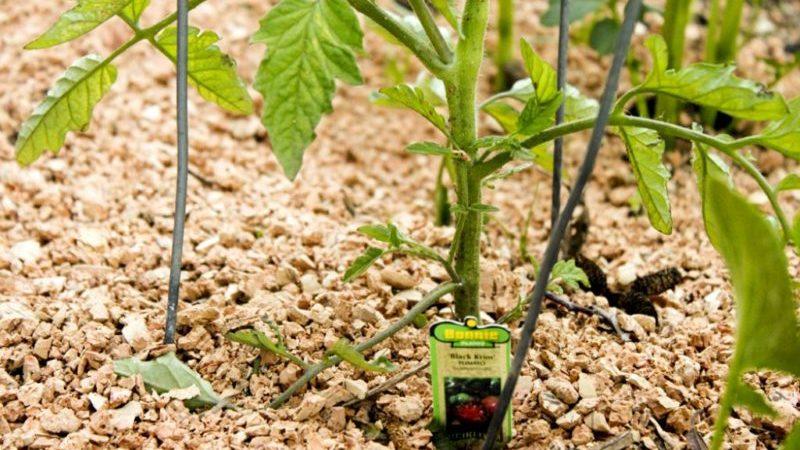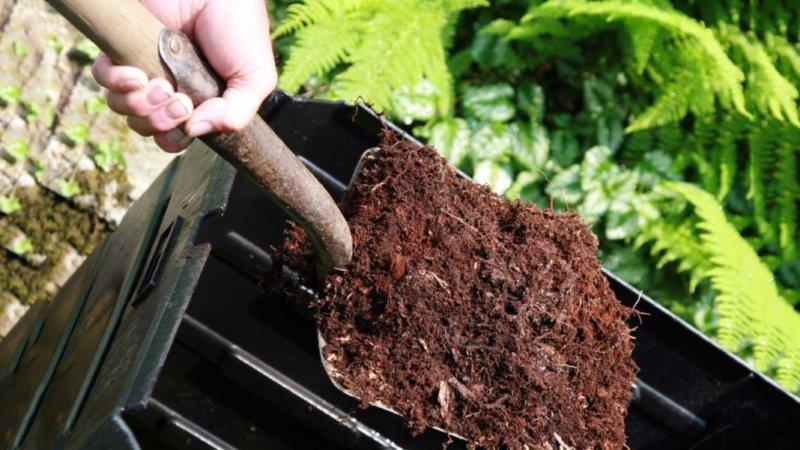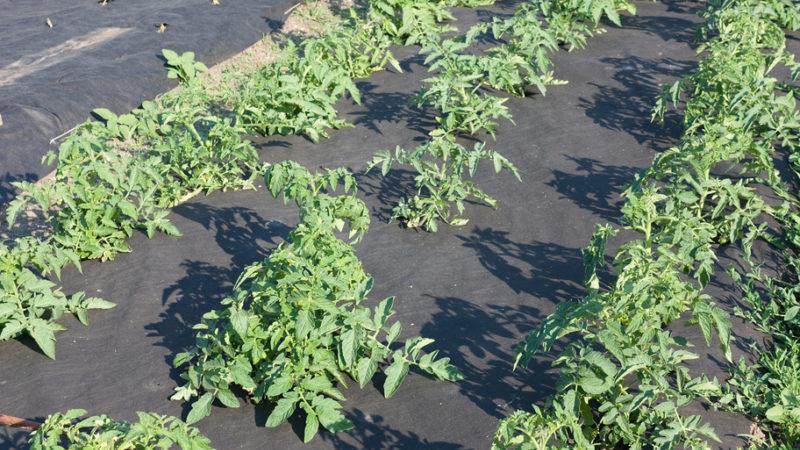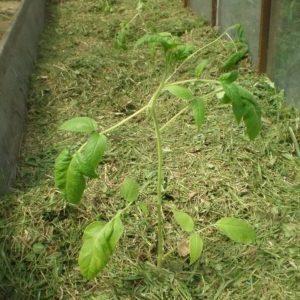What is mulching, what is it for and is it possible to mulch tomatoes with sawdust: tips and tricks
For many, gardening is an exciting hobby and an opportunity to spend time with benefit. Using simple and budgetary agricultural techniques, it is quite possible to achieve amazing fertility. For example, with proper care and optimal conditions in the greenhouse, tomato yields vary from 11 to 26 kg per bush.
But a high harvest is the result of not only and not so much physical labor, but rather a rational approach to the use of land.
In this article we will talk about one of the ways to increase the yield of tomatoes - mulching, including sawdust.
The content of the article
What is mulching and why is it necessary
Mulching is the covering of the soil surface with mulch, an organic or inorganic material that has a positive effect on yield.
This agrotechnical technique:
- improves soil properties;
- protects it from drying out and weathering;
- enriches with useful substances;
- reduces the growth of weeds;
- strengthens the root system of plants;
- reduces the time and effort for caring for plants.

How to use mulching as fertilizer
Grass mulch and other organic materials gradually decomposes, under the influence of microorganisms turning into humus and fertilizing the soil. The type of material used depends on what microelements the soil will be enriched with.
For example, coniferous mulch slightly increases the acidity of the soil, which is beneficial for crops such as sorrel, chicory, potatoes, radish, tomatoes, carrots, pumpkin.
Purpose and technology
There are 3 methods of mulching: traditional (loosening), organic and inorganic.
Each has its own advantages:
- Traditional, or loosening... After watering or rain, it keeps the soil moist and cool for longer, reduces moisture evaporation, destroys weeds, and increases the supply of oxygen to the soil.
- Organic, or organic shelter. As organic matter, straw, mown grass, compost, humus, sawdust and chips, peat, pine needles and even old newspapers and cardboard are used. This method protects the soil from drying out and weeds, increases fertility, prevents the reproduction of slugs and insect pests, and structures the soil.
- Inorganic, or shelter with inorganic materials. These include films, nonwovens, pebbles, crushed stone, gravel, expanded clay, coarse sand. The method is used to protect against drying out, weeds, pests and to prevent rot (fruits and berries do not come into contact with the ground). This mulching preserves the loose structure of the soil.

When they spend
The main mulching is carried out in autumn and spring.
In autumn, the soil is mulched after full harvest, in early to mid-October. The beds are covered, without compacting, with manure, humus, fallen leaves with a layer of 5-8 cm. In the spring, such mulch is removed on a compost heap or buried in the ground by digging or loosening.
Spring mulching is carried out after warming up the soil within the range of + 12 ... + 14 ° С.
Mulching tomatoes - benefits
It is useful to mulch tomatoes in a greenhouse and when planting in open ground.
This trick:
- protects roots from drying out and overheating;
- destroys weeds;
- prevents diseases arising from contact of plant parts with soil;
- saves time and effort on leaving;
- reduces the frequency of watering;
- enriches the land with useful substances (if organic mulch is used);
- accelerates the ripening of tomatoes by 7-10 days;
- increases productivity up to 30%.
Outdoor tomatoes mulch when the soil has warmed up well and there are no more night frosts.
Before covering the beds with mulch, the earth is well loosened or dug up, watered, and weeds are removed.
The soil is covered with organic mulch after planting the seedlings. The thickness of the layer is made 3-6 cm, while leaving a small space necessary for watering around the stem. Artificial materials are first laid out and stretched on the surface of the ridges, and then holes are made in them for planting and watering.
Mulching is carried out in heated greenhouses and hotbeds at any time of the year. In unheated ones - after warming up the ground. The rest of the process is similar to outdoor mulching.

How to mulch tomatoes: types of mulch and application
The general principles of mulching as an agrotechnical method are also applicable for the cultivation of tomatoes, there is no special “tomato” mulch. Nevertheless, when using generally accepted materials, some nuances must be taken into account.
The use of synthetic covering materials
The most common are film and nonwovens. Let's consider them in detail.
Polyethylene film
Tomato mulching film should be red, opaque and strong to drown out weed growth. Cover the soil under the tomatoes tightly, this will increase the soil temperature by 1-2 ° C.
When using such material in greenhouses, air humidity is significantly reduced due to low evaporation of moisture from the soil. This prevents the development of fungal diseases.
Feed the plants with compound fertilizer or compost before laying the film.
Keep in mind that the film does not allow air to pass through, in hot weather the soil overheats, which can lead to the death of plants. Therefore, the film is removed from time to time to ventilate the beds.

Nonwovens
Nonwoven fabrics (spunbond, lutrasil) are considered "breathable", they allow air and water to pass through, but at the same time they perfectly retain heat and protect plants from freezing. The material is chosen in black. When used in greenhouses, it will last 3 to 5 years, protecting tomatoes from weeds, pests and fungal diseases.
Use of organic materials
Organic mulching materials have proven themselves well in tomato growing. They are inexpensive (and often free) and quite affordable. Let's consider some of them.
Straw
Straw is an excellent heat insulator; during cold nights it protects the soil surface from freezing. Under the straw mulch, the soil is moist and loose. A layer of straw in the beds is a good prevention of tomato diseases: early rot, anthracnose, leaf spot. In addition, by slowly rotting, straw contributes to soil fertility.
The disadvantage of straw mulch is that rodents and pests start in a thick layer. Therefore, the straw must be removed and renewed from time to time.
Compost
Mulching tomatoes with compost is very effective. Any kind of organic waste is suitable for him. For mulching, a 3 cm layer of compost is sufficient.
However, compost needs to be handled carefully. It is best to mix it with other types of mulch as it is quickly processed by worms.

Freshly cut grass or hay
Freshly cut grass and weeded out young weeds are often used to cover the soil.The grass decomposes quickly, so the layer must be thick so that after settling its height is at least 5 cm. In this case, the soil is abundantly enriched with nitrogen and microelements. The decay process attracts worms, they additionally loosen the soil.
The disadvantage of this type of mulch is rapid decomposition, the layer of grass will have to be updated frequently.
Before laying on the beds, weeds and grass must be dried in the sun to get rid of parasitic insects.
Sawdust
Sawdust is another available mulch. Fresh sawdust retains moisture in the soil and improves its structure. Sawdust takes a long time to decompose, it is optimal to use them when mixing with compost.
In more detail about whether it is possible to mulch tomatoes in a greenhouse with sawdust, we will tell in the following sections articles.
Read also:
With what you can not and with what you can plant hot pepper next to.
We are growing a record crop of tomatoes in a polycarbonate greenhouse.
Guest in the garden, named after the star: the Canopus tomato.
Mulching tomatoes with sawdust
Wood sawdust is suitable for mulching all types of soil.
Sawdust mulch has a lot of useful properties:
- retains moisture in the soil, regulates the water balance;
- prevents the growth of weeds;
- keeps from pollution;
- scares off tomato pests;
- improves soil structure;
- accelerate fruit ripening by 7-10 days;
- increases productivity.
In addition, organic wood is more durable than grass or straw. This mulch does not require frequent updating. Sawdust can be used to mulch tomatoes both in the greenhouse and in the open field. Reception is especially effective in areas with prolonged droughts.
However, sawdust also has disadvantages. Fresh sawdust increases soil acidity, absorbs nitrogen from the soil during decomposition, sawdust from coniferous trees can negatively affect the microflora of the beds.
However, knowing about all the nuances of using mulch from sawdust for tomatoes, negative effects can be successfully avoided.

How to properly mulch tomatoes in a greenhouse with sawdust - nuances
When mulching with wood material, follow a few simple rules:
- Use only well dried material. Wet sawdust cakes, which can cause the tomatoes to dry out.
- Before laying on the beds, moisten abundantly with nitrogen fertilizer, for example, 5% urea solution.
- Mixing sawdust and compost in a 1: 1 ratio will help maintain the nutrient balance.
- Sprinkle chalk or hydrated lime on top of a layer of sawdust mulch to avoid excessive acidification of the soil.
- Lay sawdust in an even layer of 5-8 cm, otherwise it will not be possible to prevent the growth of weeds. Be sure to leave a distance to the stems for watering.
- Soil preparation is required. Weeds are removed from the beds, dug up or loosened up the soil, watered.
- Sawdust should be laid in the spring after planting seedlings in well-heated soil at a root layer temperature of about + 12 ... + 14 ° C.
Important! Sawdust mulching is not performed in its pure form.
What can not mulch tomatoes in a greenhouse
Tomatoes in the greenhouse should not be mulched with materials that, when decomposed, form harmful substances, for example, roofing material.
Do not use transparencies as they will not block the sun's rays and the weeds will keep growing. Under the transparent film, the soil overheats greatly, which can lead to the death of tomatoes.
Cardboard, newspapers, paper are too light and dry quickly. Their use in greenhouses is undesirable.
Fresh manure can "burn" the roots of plants or lead to rapid growth of green mass to the detriment of fruits.
Important! It is strictly forbidden to use pine bark - its resin destroys tomatoes.
The use of pure peat for mulching tomatoes is not advisable, as it strongly oxidizes the soil.
Gardener mistakes
If mulching did not give the expected result, most likely errors were made during execution.
The most common mistakes when mulching with sawdust:
- The use of clean sawdust without preliminary application of nitrogen fertilizers. Sawdust degrades the soil during decomposition, there will be no increased yield.
- Using fresh sawdust without chalk or hydrated lime. The acidity of the soil sharply increases, which negatively affects the growth of tomatoes.
- Sawdust was applied to unheated soil. Sawdust is a heat insulator. Placing sawdust on cold soil prevents its further warming, the growing season slows down.
- Sawdust is placed in a wet period or on too wet soil... Rotting processes occur, due to which the plants may die.
- Mulching was carried out on dry soil... The process of soil saturation with water is difficult; tomatoes suffer from a lack of moisture. A layer of mulch laid on dry ground is quickly carried away by the wind.
- Incorrect layer height selected. Too thick layer quickly cakes and prevents oxygen from reaching the roots. Too thin will not protect against weeds, poorly retain moisture. The optimum layer height for sawdust is 5-8 cm.
- Mulching untreated soil. The layer of mulch will not kill already growing weeds, it will not make the compacted soil loose.

Useful Tips
The mulching process benefits not only vegetables, berries and fruit trees. The paths are covered with chips or sawdust - this protects them from erosion and weeds. In this case, the layer of mulch should have a thickness of 8-10 cm.
Flowerbeds can be mulched with tree bark. This will increase their decorative effect.
Conclusion
Mulching is a simple but effective agricultural technique. Covering the soil surface with inorganic or organic materials retains moisture, protects against weeds, pests and diseases, enriches the beds with nutrients (if the mulch is organic), keeps fruits clean, accelerates ripening, and increases yields.
Compliance with the rules of mulching is of great importance. This procedure is performed only on warm and prepared soil (free from weeds, loosened, watered). Remember that each mulching material has its own characteristics of use. Having followed all the simple rules, you will get a high yield, significantly reducing time and labor costs.